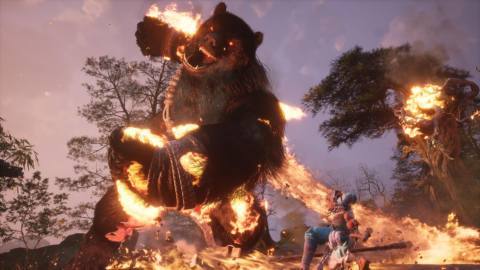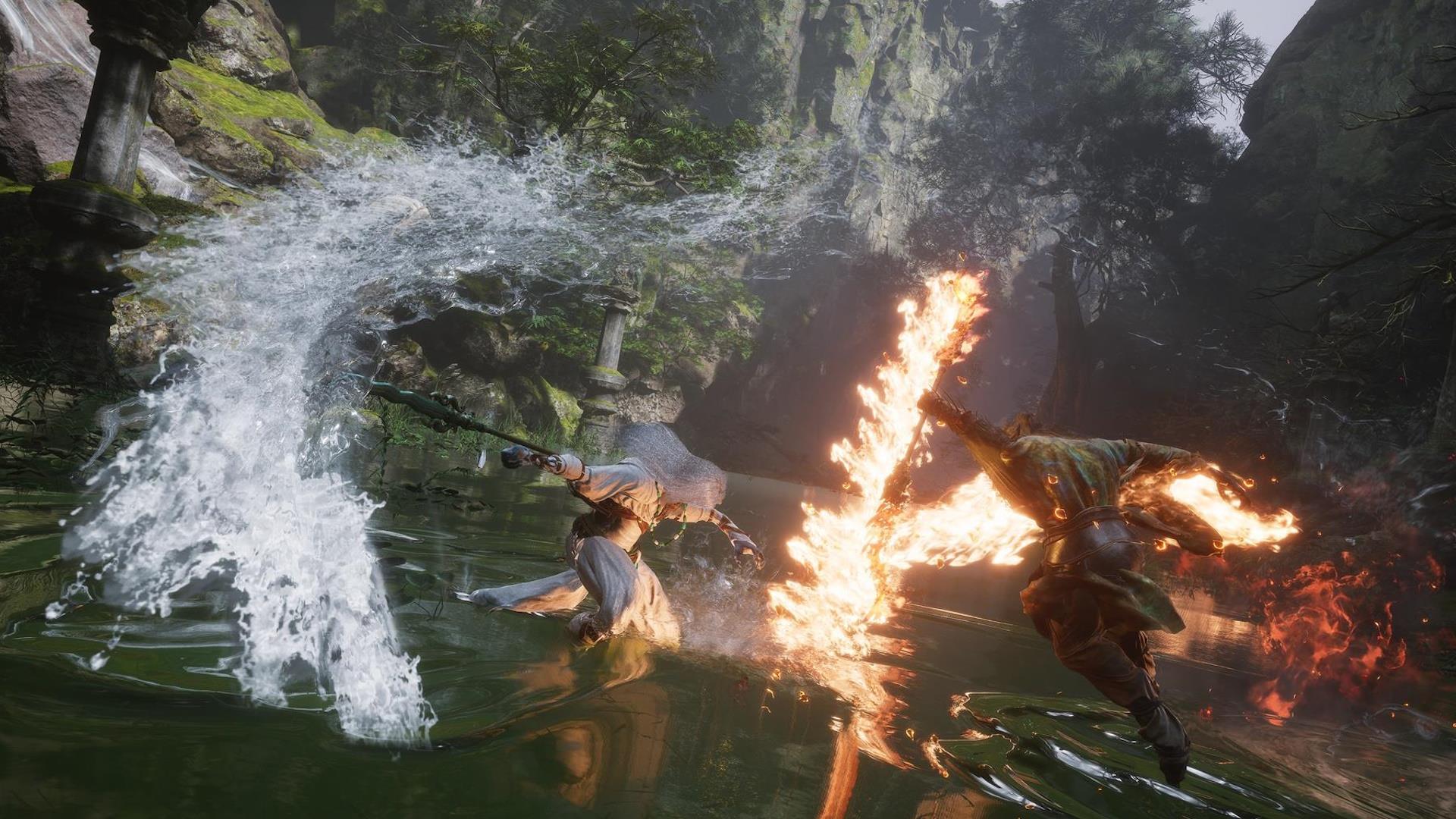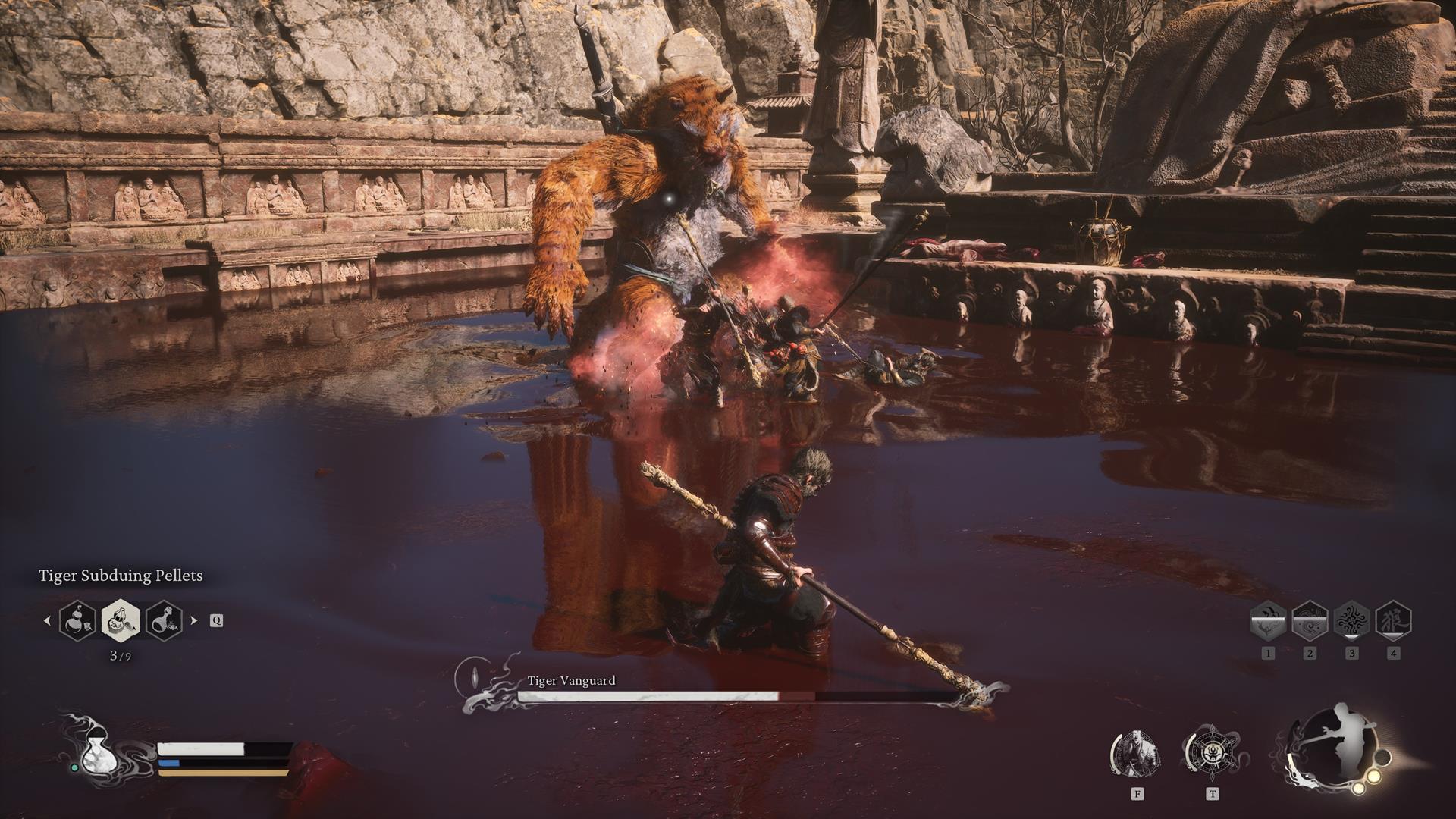
There was a moment, roughly 20 hours into my near-40-hour playthrough of Black Myth: Wukong, when things finally clicked. A few chapters prior to that point had left me scratching my head, baffled at the introduction of various minor characters, adversaries, and concepts. But at that moment halfway through, when things finally became clearer, I couldn’t help but smile. I was hooked, and there was no going back.
Black Myth: Wukong, made by China-based studio Game Science, is an action role-playing game inspired by Journey to the West. It, along with Romance of the Three Kingdoms, Water Margin, and Dream of the Red Chamber, is one of the great pillars of Chinese literature. To adapt the story of Journey to the West, a timeless classic with characters and themes that have remained influential throughout East Asia, is already a daunting task. Thankfully, Game Science has managed to pull off the impossible, weaving together a narrative that’s intricate, original, and, at times, thought-provoking.
The hardest part about writing this review of Black Myth: Wukong is that the review embargo stipulates that we’re not allowed to divulge too many details about the game’s plot outside of a couple of chapters. Suffice it to say, you play as the Destined One, a monkey warrior tasked with retrieving relics that have been lost. You set out on your own odyssey — perhaps not “to the West,” but through six chapters of action and world-building.
As a Filipino, I consider myself more of a Romance of the Three Kingdoms buff, though I briefly read Journey to the West ages ago during my high school years. Nevertheless, I did appreciate the campaign’s inclusion of numerous characters and plot points, as well as Buddhist teachings and Daoist philosophy, from the novel. These are either shown in detail, relayed in poems, or mentioned in passing, some of which made me go, “I understood that reference.”
The narrative is also about a certain companion’s background, which I don’t want to spoil here. The story explores themes of lifelong regrets, sacrifice, the immutable shaping of one’s fate, and the notion that everyone, heroes and villains alike, might just be seeking redemption or a place in the sun. The entire campaign’s arc, steeped in Chinese and wider Asian cultural traditions, is woven like fine tapestry and is further complemented by gorgeous visuals and scenes that left me in awe.

Similar to Journey to the West, my adventure in Black Myth: Wukong took me to several regions. From lush forests and sand-swept deserts to snow-covered fields and mountains of magma, each environment felt intricately crafted, as though taken from the pages of the novel and brought to life. These biomes are subdivided into multiple areas; the game is not an open world, though there are some large sections with multiple branching paths that lead to more enemies and rewards.
For instance, one chapter took place in a hollowed-out underground cavern that’s crawling with innumerable spiders, centipedes, and all manner of many-legged creatures. I followed one winding path that led me to several major bosses. Then, I fast-traveled to a previously visited shrine and I took another fork in the road. I eventually stumbled upon some optional bosses, including a scorpion monk that had escaped to some other part of the cave system. These paths also had some nifty HP, mana, and flask upgrades, as well as tranquil meditation spots. And these are just from the initial zone in this particular chapter; the second half actually takes place in a temple complex atop a mountain! The sheer scale of each level made all of them both daunting and extraordinarily stunning in equal measure.
There are many side quests and secrets, too. For example, I rang shrine bells in the first level, which caused me to get teleported to a hidden temple. In the desert biome, meanwhile, I collected eyes from Buddha statues. I also helped break the curse of a man who’d been trapped in stone, who then sold key items. Later, I tackled the objectives to unlock a hub, allowing vendor NPCs to move to my humble abode. Completing these activities, some of which involved solving cryptic riddles, was a gratifying experience.
Surprisingly enough, there’s no map whatsoever, and I do admit to getting lost several times. However, learning from the exploits of Journey to the West’s Tang Sanzang, Sun Wukong, Zhu Baije, and company, I embraced the notion of exploration, investigating mysterious locales and facing all sorts of perils. Without any hand-holding, I was free to explore to my heart’s content — which naturally made discoveries even more rewarding.

Enemy design in Black Myth: Wukong is also nothing short of outstanding, with the game boasting countless variants of hostiles, known as yaoguai, and nearly 80 bosses to encounter during your travels. You’ve got everything from masked monks and anthropomorphic creatures like zodiac animals to celestial entities, gargantuan goliaths, shambling undead that wield different armaments, and even a great dragon that flies around while striking you with lightning.
Some foes are surprisingly macabre in nature, almost with a dark fantasy flair, including twin-headed priests that induce madness, ogres that carry the skeletal remains of their beloved, misshapen entities in the throes of corruption, and an angel-like general with a hand for a head. It’s not just the sheer epicness of these battles that makes them memorable, but also the way the game’s designers have lovingly crafted the characters and creatures in homage to the legendary tale and regional folklore.
The number of bosses in the game made for a challenging romp, as each opponent had their own movesets and abilities that I had to watch out for. Fortunately, Black Myth: Wukong more than holds its own in the action department, thanks to fast-paced combat, fluid animations, responsive controls, and a plethora of moves at my disposal.
As the Destined One, I made use of various magic spells, such as turning into a mist decoy, immobilizing a foe, and summoning multiple duplicates of myself. There are myriad transformations, too, akin to Sun Wukong’s powers. Spirit forms momentarily turn you into an elite enemy that you defeated to cast their spell, somewhat akin to Castlevania: Aria of Sorrow. The actual transformations, meanwhile, cause you to shape-shift into larger creatures with their own health bars and unique movesets. My favorite has to be the Yin Tiger, which allowed me to deflect incoming blows before countering with a devastating slam using my Buster Sword-esque blade.

As for general melee combat, Black Myth: Wukong only lets you wield one type of weapon: a staff with three battle stances. While this concept is understandable lore-wise for a monkey warrior, it unfortunately does result in monotonous gameplay as time wears on. At best, each stance’s charged attack and mixed combos tend to be different, but normal attack flurries are the same. When I finally unlocked the defensive-counter-oriented Thrust Stance at level 20, which had a backstep move to avoid hits, I barely used the others.
In relation to the above, although there are dozens of enemy forms that you can turn into, they’re still limited to two keybinds, one for spirit casts and one for transformations, and by resources that are easily spent. Parrying, a staple of the Soulslike genre, isn’t available by default either. Instead, it’s unlocked as a spell, so I relied more on dodging blows. In effect, I mostly just performed the same melee combos, interspersed with a select few magical abilities, which made the whole affair repetitive after a while.
Furthermore, theorycrafting or experimentation with different builds in Black Myth: Wukong isn’t that viable, at least in my initial playthrough. Although I completed the campaign at level 80 and it’s possible to respec at any shrine, I still had to put a lot of points into stances and stat boosts. I only had enough left to allocate for a few spell perks, and not a lot to assign for transformation perks themselves. Compared to other Soulslike games, I can’t say if magic-focused or transformation-focused builds would be workable in practice.

Performance-wise, I reviewed the game on PC. With an Nvidia RTX 3080, Intel i9-10900K, and 32 GB of RAM, I experienced smooth performance at 4K resolution and with higher graphics settings selected. Note that I wasn’t able to try raytracing, since we were told that there were issues with the current pre-release build.
All in all, Black Myth: Wukong is an astounding triumph, one that blends a story celebrating Chinese and other East Asian cultures with an original retelling that has resonant themes, all complemented by spectacular design and exhilarating combat. While the narrative is confusing at first — as I can personally attest to — it nonetheless encourages you to embrace that sense of strangeness and wonder as you venture into distant lands, much like a certain journey written centuries ago that has stood the test of time.
Black Myth: Wukong will be released Aug. 20 on PlayStation 5 and Windows PC. The game was reviewed on Windows PC using a download code provided by Game Science. Vox Media has affiliate partnerships. These do not influence editorial content, though Vox Media may earn commissions for products purchased via affiliate links. You can find additional information about Polygon’s ethics policy here.
